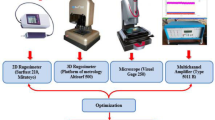Abstract
The optimisation problem of multifunctional cutting tools, including multistep and combination tools, has been investigated. The tools' concepts for their physical understanding are discussed in order to provide the necessary background for the reader. Since they are not available in the literature, the necessary mathematical models for the optimsation are analysed based on constant tool speed (rpm), constant surface speed and variable speed or feed for each tool step and/or function. The integration of the mathematical models in optimisation schemes results in an analytical design tool for modelling and simulation of the advanced multifunctional tools in an early part processing stage that refines the process and tooling approaches while determining the sensitivity of these tools to the performance and production cost of individual machines. The aforementioned problem has been theoretically analysed here, while heuristic optimisation algorithms for determining the optimum cutting speed(s) and feed(s) for the multifunctional tools are presented in Part II of this paper. Experimental results and analytical examples which demonstrate the effectiveness and advantages of the proposed approach utilising the described mathematical models are presented in Part II.
Similar content being viewed by others
References
S. Hinduja, D. J. Petty, M. Tester and G. Barrow, “Calculation of optimum cutting conditions for turning operations”,Proceedings of the Institute of Mechanical Engineers,199 (B2), pp. 81–92, 1985.
K. Iwata,et al., “A probabilistic approach to the determination of the optimum cutting conditions”,ASME Journal of Engineering for Industry, pp. 1099–1107, November 1972.
S. K. Hati and S. S. Rao, “Determination of optimum machining conditions—Deterministic and probabilistic approaches’,ASME Journal of Engineering for Industry, pp. 354–359, February 1976.
A. I. Daschenko and V. N. Redin, “Control of cutting tool replacement by durability distributions”,The International Journal of Advanced Manufacturing Technology,3(5), pp. 39–60, 1988.
J. M. Pan, W. J. Kolarik and B. K. Lambert, “Mathematical model to predict system reliability to tooling for automated machining systems”,International Journal of Production Research,24(3), pp. 493–505, 1986.
S. Rossetto and A. Zompi, “A stochastic tool-life model”,Journal of Engineering for Industry, Transactions of the ASME,103, pp. 126–130, 1981.
J. S. Agapiou, “The optimization of single or multipass machining operation based on a combined criterion” inProceedings, Advances in Manufacturing Systems Engineering, eds M. Anjanappa and D. K. Anand, ASME Winter Annual meeting, San Francisco, CA, pp. 103–115, December 1989.
J. S. Agapiou, “Optimization of single-stage multifunctional systems”,Proceedings of Manufacturing International '90 Conference, Vol. IV, Intelligent Manufacturing Structure, Control, and Integration, Atlanta, GA, pp. 289–299, March 1990.
G. Peter and M. Kaufeld, “Rapid drilling and milling”,Industrial and Production Engineering,12(4), pp. 56–60, 1988.
Author information
Authors and Affiliations
Rights and permissions
About this article
Cite this article
Agapiou, J.S. Cutting tool strategies for multifunctional part configurations: Part I—analytical economic models for cutting tools. Int J Adv Manuf Technol 7, 59–69 (1992). https://doi.org/10.1007/BF02601572
Accepted:
Issue Date:
DOI: https://doi.org/10.1007/BF02601572



